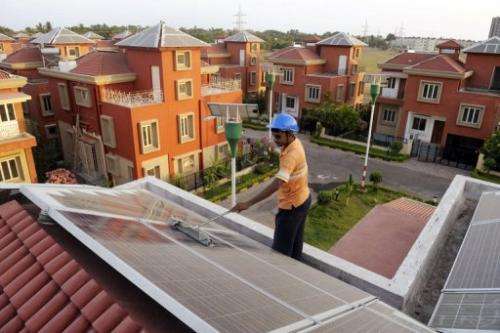Cities on front line of climate change

The world's cities face the brunt of climate change but some are starting to respond vigorously to the threat, experts say at a conference here staged ahead of the June Rio summit.
More than half of the world's population of seven billion currently lives in cities and by 2050, this is expected to increase to 70 percent, or around 6.4 billion, according to UN figures.
More than 60 percent of the increase will occur in Asian cities -- and nearly half of the growth will happen in cities that currently have 500,000 inhabitants or fewer.
It means that cities will face unparalleled challenges when climate change starts to bite, scientists said Monday at a meeting on the world's environment ahead of the June 20-22 summit.
"Cities are emerging as first responders. They are on the frontline, both in the cause and effect of climate change," said Cynthia Rosenzweig, who heads the Climate Impacts Group at the NASA Goddard Institute for Space Studies.
The hazards facing cities are many.
By 2100, or sooner, heatwaves, droughts, storms and floods are expected to become more frequent and last longer. Cities built on deltas or on the coast will face rising seas, which threaten homes and drinking water.
That raises mighty questions about water supplies, drainage and flood defences and the resilience of homes, offices, factories and transport systems.
In 2003, one of the hottest summers on record killed around 35,000 people in Europe. Some climate scientists predict that by the 2040s, more than half of the continent's summers will be warmer than that of 2003.

Alex de Sherbinin of the Earth Institute at New York's Columbia University pointed to a dangerous phenomenon called the urban heat island.
Cities can hold pockets of heat that are up to four to six degrees Celsius (7.2-10.8 degrees Fahrenheit) greater than in the surrounding countryside.
The warmth comes from the reflected radiation from treeless streets sealed in heat-trapping black tarmac; from buildings in "street canyons" which block cooling breezes; and from heat discharged by air conditioning ducts.
Those most at risk are the elderly, battling heat stress and air pollution, and the poor, who cannot afford to cool their homes or or move elsewhere, he said.
All cities will be challenged by shifting climate, but some will be more exposed or cope better than others, said Stephen Tyler, working with a group called the Asian Cities Climate Change Resilience Network (ACCCRN).
He sounded the alarm for cities that are middle-sized today but will soon face a double whammy -- heavy migration that can lead to slums, and the impact of climate change.
"The middle cities are often ignored by governments, yet they are also the primary target for poor people who leave the countryside and aim for the nearest urban centre," said Tyler.
"But in terms of coping, it's not the city's size which counts, but its ability to provide the services, the infrastructure."
Far from being sitting ducks, many cities are working to shore up their climate defences and ease their greenhouse-gases, said Rosenzweig. Around 70 percent of carbon dioxide (CO2) emissions can be attributed to city needs.
Initiatives include painting roofs white to reflect sunlight, having porous pavements that allow rainwater to replenish the aquifer, planting trees and parks to alleviate heat islands and regulating traffic pollution, which has benefits for health and carbon mitigation.
Hospitals and neighbourhood groups are also asked to watch out for old people who may be struggling in a heatwave. Cities that are set to expand can plan their zoning laws, urban density, energy use and traffic system accordingly, which saves having to expensively fix things afterwards.
Rosenzweig, who co-authored a report by a group called the Urban Climate Change Research Network into how global warming will hit urban dwellers, said local governments had powers and the ability to act.
Municipalities are moving into the vacuum left by the UN or national governments, whose work on climate change has marked time since the ill-fated 2009 Copenhagen Summit, she explained.
In 2005, the so-called C40 Cities Climate Leadership Group was set up, and this was followed five years later by the World Mayors Council on Climate Change. It has 60 cities on its roster, swapping ideas and networking.
"City leaders are practical and responsive," she said. "They are there day after day, and they have experience in climate-related disasters."
(c) 2012 AFP

















